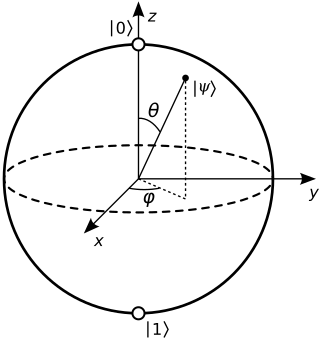
In quantum computing, a qubit or quantum bit is a basic unit of quantum information—the quantum version of the classic binary bit physically realized with a two-state device. A qubit is a two-state quantum-mechanical system, one of the simplest quantum systems displaying the peculiarity of quantum mechanics. Examples include the spin of the electron in which the two levels can be taken as spin up and spin down; or the polarization of a single photon in which the two spin states can also be measured as horizontal and vertical linear polarization. In a classical system, a bit would have to be in one state or the other. However, quantum mechanics allows the qubit to be in a coherent superposition of multiple states simultaneously, a property that is fundamental to quantum mechanics and quantum computing.
In quantum mechanics, a density matrix is a matrix that describes the quantum state of a physical system. It allows for the calculation of the probabilities of the outcomes of any measurement performed upon this system, using the Born rule. It is a generalization of the more usual state vectors or wavefunctions: while those can only represent pure states, density matrices can also represent mixed states. Mixed states arise in quantum mechanics in two different situations:
- when the preparation of the system is not fully known, and thus one must deal with a statistical ensemble of possible preparations, and
- when one wants to describe a physical system that is entangled with another, without describing their combined state; this case is typical for a system interacting with some environment.
In physics, the CHSH inequality can be used in the proof of Bell's theorem, which states that certain consequences of entanglement in quantum mechanics cannot be reproduced by local hidden-variable theories. Experimental verification of the inequality being violated is seen as confirmation that nature cannot be described by such theories. CHSH stands for John Clauser, Michael Horne, Abner Shimony, and Richard Holt, who described it in a much-cited paper published in 1969. They derived the CHSH inequality, which, as with John Stewart Bell's original inequality, is a constraint—on the statistical occurrence of "coincidences" in a Bell test—which is necessarily true if an underlying local hidden-variable theory exists. In practice, the inequality is routinely violated by modern experiments in quantum mechanics.

Quantum decoherence is the loss of quantum coherence, the process in which a system's behaviour changes from that which can be explained by quantum mechanics to that which can be explained by classical mechanics. In quantum mechanics, particles such as electrons are described by a wave function, a mathematical representation of the quantum state of a system; a probabilistic interpretation of the wave function is used to explain various quantum effects. As long as there exists a definite phase relation between different states, the system is said to be coherent. A definite phase relationship is necessary to perform quantum computing on quantum information encoded in quantum states. Coherence is preserved under the laws of quantum physics.
The Fock space is an algebraic construction used in quantum mechanics to construct the quantum states space of a variable or unknown number of identical particles from a single particle Hilbert space H. It is named after V. A. Fock who first introduced it in his 1932 paper "Konfigurationsraum und zweite Quantelung".
In quantum physics, a measurement is the testing or manipulation of a physical system to yield a numerical result. A fundamental feature of quantum theory is that the predictions it makes are probabilistic. The procedure for finding a probability involves combining a quantum state, which mathematically describes a quantum system, with a mathematical representation of the measurement to be performed on that system. The formula for this calculation is known as the Born rule. For example, a quantum particle like an electron can be described by a quantum state that associates to each point in space a complex number called a probability amplitude. Applying the Born rule to these amplitudes gives the probabilities that the electron will be found in one region or another when an experiment is performed to locate it. This is the best the theory can do; it cannot say for certain where the electron will be found. The same quantum state can also be used to make a prediction of how the electron will be moving, if an experiment is performed to measure its momentum instead of its position. The uncertainty principle implies that, whatever the quantum state, the range of predictions for the electron's position and the range of predictions for its momentum cannot both be narrow. Some quantum states imply a near-certain prediction of the result of a position measurement, but the result of a momentum measurement will be highly unpredictable, and vice versa. Furthermore, the fact that nature violates the statistical conditions known as Bell inequalities indicates that the unpredictability of quantum measurement results cannot be explained away as due to ignorance about "local hidden variables" within quantum systems.

In quantum mechanics and computing, the Bloch sphere is a geometrical representation of the pure state space of a two-level quantum mechanical system (qubit), named after the physicist Felix Bloch.
In quantum computing and specifically the quantum circuit model of computation, a quantum logic gate is a basic quantum circuit operating on a small number of qubits. They [quantum logic gates] are the building blocks of quantum circuits, like classical logic gates are for conventional digital circuits.
In quantum information theory, a quantum channel is a communication channel which can transmit quantum information, as well as classical information. An example of quantum information is the state of a qubit. An example of classical information is a text document transmitted over the Internet.
A qutrit is a unit of quantum information that is realized by a 3-level quantum system, that may be in a superposition of three mutually orthogonal quantum states.

LOCC, or local operations and classical communication, is a method in quantum information theory where a local (product) operation is performed on part of the system, and where the result of that operation is "communicated" classically to another part where usually another local operation is performed conditioned on the information received.
In functional analysis and quantum information science, a positive operator-valued measure (POVM) is a measure whose values are positive semi-definite operators on a Hilbert space. POVMs are a generalization of projection-valued measures (PVM) and, correspondingly, quantum measurements described by POVMs are a generalization of quantum measurement described by PVMs.

In physics, in the area of quantum information theory, a Greenberger–Horne–Zeilinger state is a certain type of entangled quantum state that involves at least three subsystems. The four-particle version was first studied by Daniel Greenberger, Michael Horne and Anton Zeilinger in 1989, and the three-particle version was introduced by N. David Mermin in 1990. Extremely non-classical properties of the state have been observed. GHZ states for large numbers of qubits are theorized to give enhanced performance for metrology compared to other qubit superposition states.
A decoherence-free subspace (DFS) is a subspace of a quantum system's Hilbert space that is invariant to non-unitary dynamics. Alternatively stated, they are a small section of the system Hilbert space where the system is decoupled from the environment and thus its evolution is completely unitary. DFSs can also be characterized as a special class of quantum error correcting codes. In this representation they are passive error-preventing codes since these subspaces are encoded with information that (possibly) won't require any active stabilization methods. These subspaces prevent destructive environmental interactions by isolating quantum information. As such, they are an important subject in quantum computing, where (coherent) control of quantum systems is the desired goal. Decoherence creates problems in this regard by causing loss of coherence between the quantum states of a system and therefore the decay of their interference terms, thus leading to loss of information from the (open) quantum system to the surrounding environment. Since quantum computers cannot be isolated from their environment and information can be lost, the study of DFSs is important for the implementation of quantum computers into the real world.

In the context of quantum mechanics and quantum information theory, symmetric, informationally complete, positive operator-valued measures (SIC-POVMs) are a particular type of generalized measurement (POVM). SIC-POVMs are particularly notable thanks to their defining features of (1) being informationally complete; (2)having the minimal number of outcomes compatible with informational completeness, and (3) being highly symmetric. In this context, informational completeness is the property of a POVM of allowing to fully reconstruct input states from measurement data.
Entanglement distillation is the transformation of N copies of an arbitrary entangled state into some number of approximately pure Bell pairs, using only local operations and classical communication.
In quantum mechanics, and especially quantum information theory, the purity of a normalized quantum state is a scalar defined as
In quantum computing, the quantum Fourier transform (QFT) is a linear transformation on quantum bits, and is the quantum analogue of the discrete Fourier transform. The quantum Fourier transform is a part of many quantum algorithms, notably Shor's algorithm for factoring and computing the discrete logarithm, the quantum phase estimation algorithm for estimating the eigenvalues of a unitary operator, and algorithms for the hidden subgroup problem. The quantum Fourier transform was discovered by Don Coppersmith.
Given a Hilbert space with a tensor product structure a product numerical range is defined as a numerical range with respect to the subset of product vectors. In some situations, especially in the context of quantum mechanics product numerical range is known as local numerical range
In quantum physics, the "monogamy" of quantum entanglement refers to the fundamental property that it cannot be freely shared between arbitrarily many parties.























